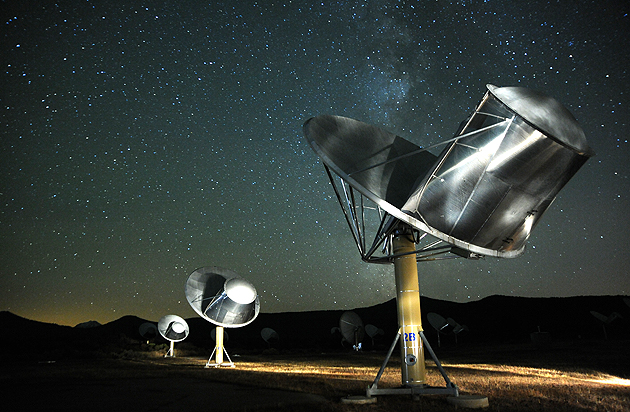
Are we alone in the universe?
An international group of astronomers has detected an interesting radio signal spike, one that could possibly be of alien origin, from a star system located 95 light-years away.
Scientists who search for extraterrestrial intelligence in the universe, a field known as SETI, find the powerful signal unique enough to warrant permanent monitoring of the signal’s source.
Few details have been released so far, but more information about the finding will be announced at the International Astronautical Congress (IAC), which will be held in Guadalajara, Mexico during the last week of September.
Of course, it is very likely that the radio spike was produced by something else entirely, like Earth-based radio interference or even a technical glitch in the observing equipment.
To rule out other possibilities, follow-up observations will need to be made from various radio telescopes around the world. However, these follow-up observations from other organizations have not yet been possible because those who detected the signal sat on the discovery for over a year for unknown reasons.
The signal was detected on May 15, 2015 by astronomers from the Russian Academy of Sciences’ Special Astrophysical Observatory. Typically, scientists would publicize a finding like this so other astronomers could point their own telescopes toward the source and, in a way, “check their work.”

RATAN-600 radio telescope used to detect the signal / Image courtesy of the Russian Academy of Sciences
To search for intelligent life elsewhere in the universe, SETI astronomers listen for radio signals. It’s believed that if ET were to attempt contact, it would likely be through powerful radio waves, which travel through the universe at the speed of light. If we wanted to send a message to a civilization far away, this is what we’d do, so, for now, we assume that intelligent aliens would do the same.
But electromagnetic waves, like radio waves, are also found naturally in the cosmos, making the work of SETI astronomers all the more challenging. Because of this, it’s important that SETI astronomers from around the world, using different radio telescopes, work together to rule out all other non-ET possibilities for the source of the signal.
Seth Shostak, senior astronomer at the SETI Institute, told GeekWire, “This is a bit of a puzzling story, as the Russians found this signal a year ago or so, but just didn’t let others know. That’s not good policy, as what you really want is confirmation at another telescope, but… Is it real? The signal may be real, but I suspect it’s not ET. There are other possibilities for a wide-band signal such as this, and they’re caused by natural sources (or even terrestrial interference).”
But here’s what we know right now. The signal came from the direction of the star HD 164595, located in the constellation Hercules. HD 164595 is interesting because it’s considered to be a Sun-like star. It’s 6.3 billion years old (our Sun is 4.5 billion years old) and 0.99 times the mass of our Sun.
More importantly, an exoplanet has already been identified orbiting HD 164595. Known as HD 164595 b, the planet is thought to be a warm-Neptune-type gas giant. However, HD 164595 b doesn’t meet the typical “potentially habitable planet” requirements: it’s not a rocky planet and not in the habitable zone of its star.

Size of HD 164595 b compared to other planetary bodies in our solar system / Image courtesy of the Open Exoplanet Catalogue
Then again, nature has always proven to have a better imagination than humans, and life on this type of planet can’t be ruled out entirely. There’s also the possibility that other, more Earth-like exoplanets are orbiting HD 164595 and simply haven’t been discovered yet.
For now, we’ll have to hold our excitement until other SETI astronomers can make follow-up observations. Luckily, there are projects like Yuri Milner’s $100 million Breakthrough Listen to fund efforts like this.
If the data from the Russian Academy of Sciences checks out, this could be the next “WOW signal” — a similarly interesting radio spike detected in 1977 in the direction of the Sagittarius constellation, named because the astronomer who identified it wrote “WOW” next to the data.
In the case of the WOW signal, the possibility of an intelligent source was never ruled out, but no other interesting radio signals from that origin have been detected since.
So, is ET trying to contact us? We’ll just have to wait until the IAC conference in a few weeks for the astronomers responsible to release more information about their findings.
No comments:
Post a Comment